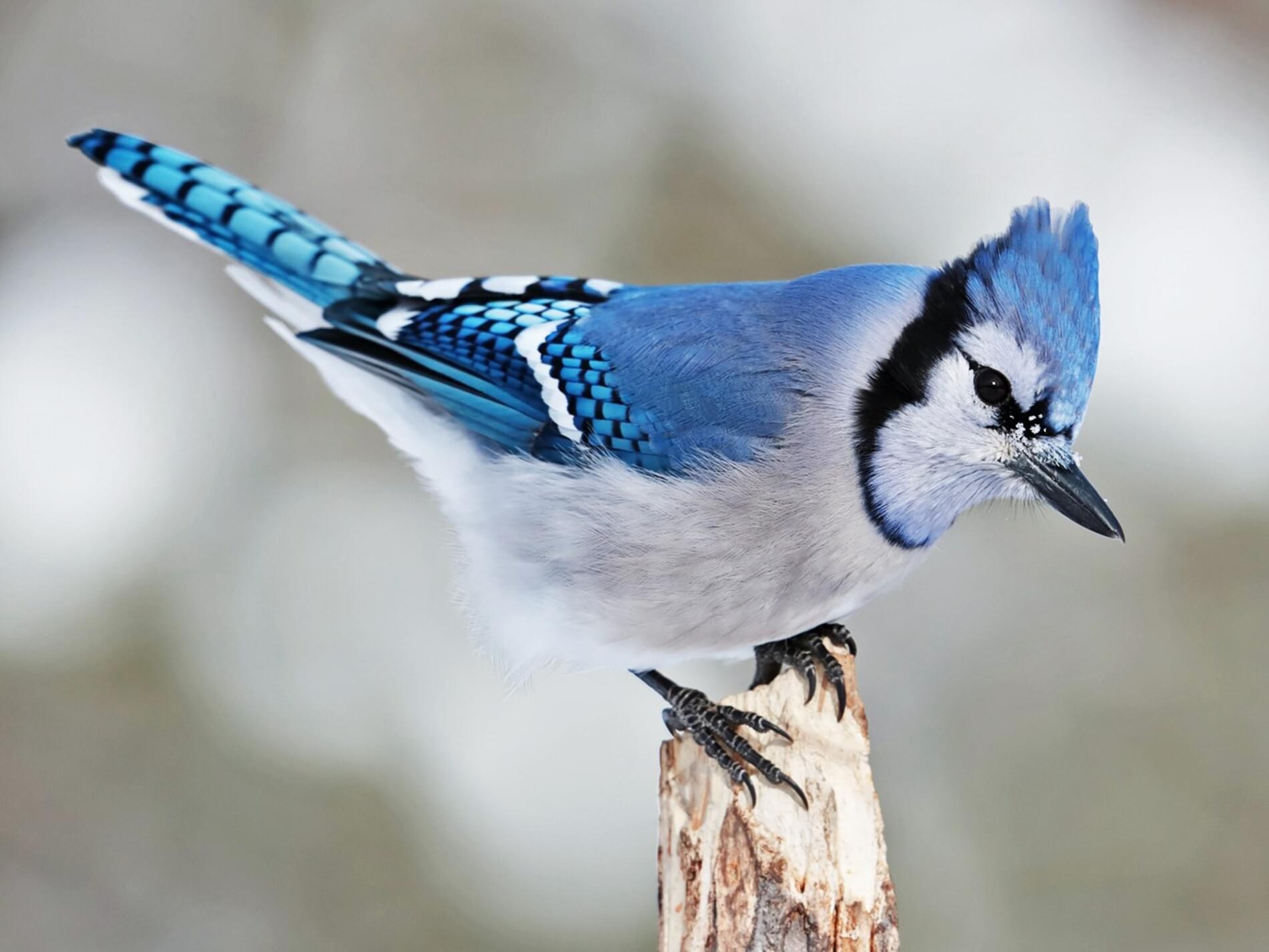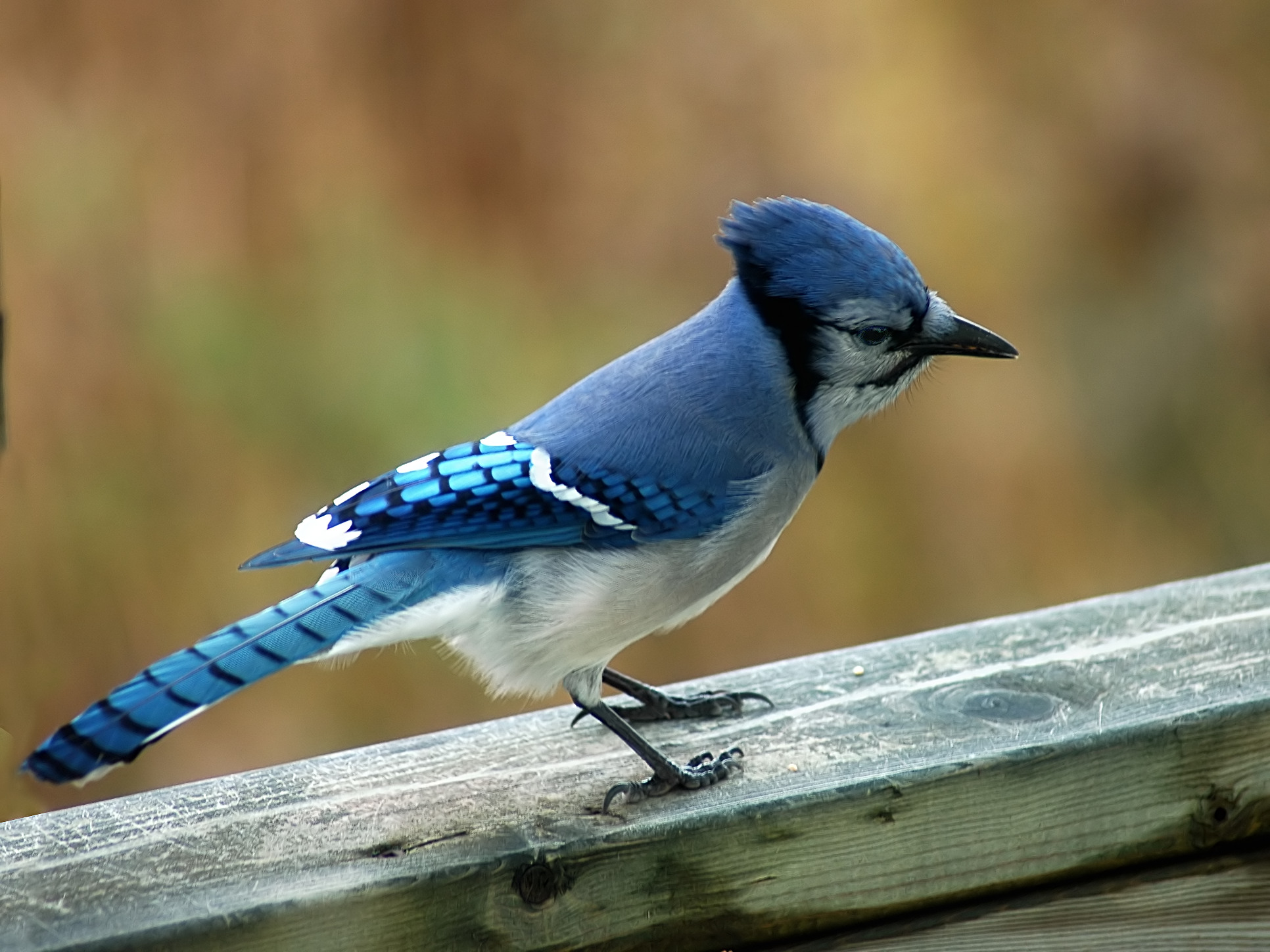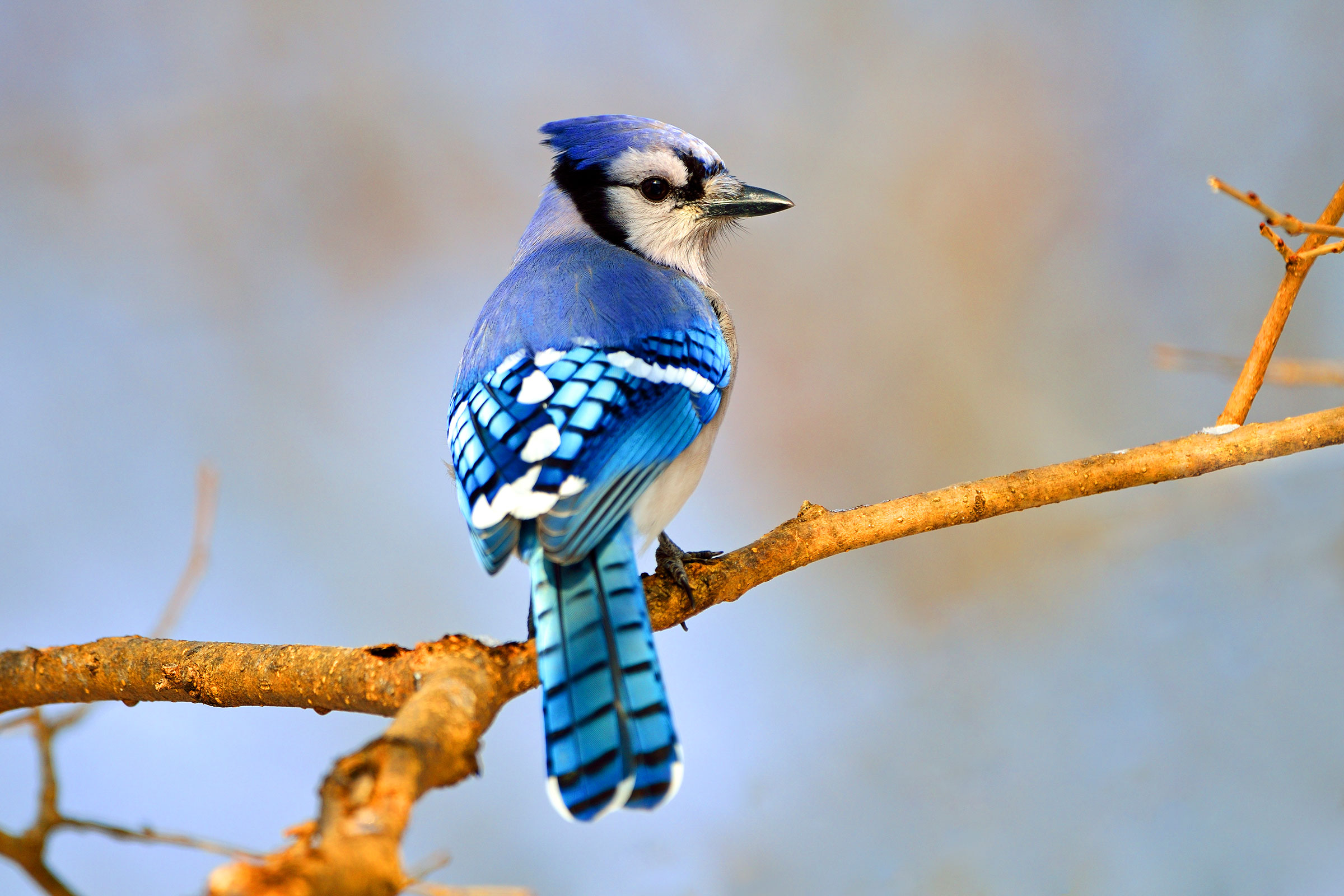Blue Jays in Nature

The blue jay, a common and conspicuous bird throughout much of North America, is a fascinating creature that embodies the beauty and resilience of the natural world. With its striking plumage, bold personality, and remarkable intelligence, the blue jay has captivated birdwatchers and nature enthusiasts for generations.
Physical Characteristics, Blue jays
The blue jay is easily recognizable with its vibrant blue and white plumage. Its head is crested with a distinctive, upright tuft of feathers that can be raised or lowered depending on the bird’s mood. The back, wings, and tail are a rich, deep blue, while the underside is white with black barring. The blue jay’s wings are relatively long and pointed, giving it a graceful appearance in flight. Its beak is stout and pointed, adapted for cracking seeds and nuts. Blue jays typically measure around 10-12 inches in length with a wingspan of 15-18 inches.
Habitat Preferences
Blue jays are adaptable birds and can be found in a variety of habitats, but they prefer deciduous forests, woodlands, and suburban areas with mature trees. These areas provide them with ample food sources, nesting sites, and protection from predators. They are often seen in parks, gardens, and backyards, especially where there are oak trees, which provide them with acorns, a staple food source.
Diet
Blue jays are omnivorous birds with a diverse diet that includes a wide range of food items. Their diet consists primarily of nuts, seeds, fruits, and insects. They are known for their opportunistic foraging behavior and will readily scavenge for food in garbage cans, bird feeders, and other areas where food is available. Blue jays are also known to cache food, hiding it away for later consumption.
Breeding Habits
Blue jays are monogamous birds and typically form pair bonds that can last for several years. They build their nests in trees, usually high up in the branches, using twigs, leaves, and other materials. The female lays 3-7 eggs, which are incubated for about 17 days. Both parents share the responsibility of incubating the eggs and feeding the chicks. The chicks leave the nest after about 3-4 weeks and remain dependent on their parents for a few more weeks before becoming independent.
Role in the Ecosystem
Blue jays play a significant role in the ecosystem, acting as both predators and prey. They are known to prey on insects, small mammals, and other birds’ eggs, helping to control populations of these species. They are also preyed upon by larger birds of prey, such as hawks and owls. Blue jays are also important seed dispersers, helping to spread the seeds of plants throughout their range.
Blue Jays in Human Culture

The blue jay, with its vibrant plumage and boisterous calls, has captivated human imagination for centuries, finding its way into various aspects of human culture. From folklore and mythology to art and literature, the blue jay’s presence has left an indelible mark on our understanding of the natural world and our place within it.
Blue Jays in Folklore and Mythology
Folklore and mythology offer a glimpse into the cultural significance of the blue jay across different societies. In many cultures, the blue jay is associated with various symbolic meanings, often reflecting its unique characteristics. For example, in Native American folklore, the blue jay is often seen as a trickster figure, known for its intelligence, mischievous nature, and ability to mimic other birds.
- In the Iroquois tradition, the blue jay is believed to be a messenger of the Great Spirit, capable of conveying messages between the spiritual realm and the human world.
- Among the Algonquin people, the blue jay is associated with the spirit of the forest, often seen as a protector of the woodlands and a symbol of wisdom.
- In some cultures, the blue jay is also associated with the concept of transformation and rebirth, its bright blue plumage symbolizing the renewal of life.
Blue Jays in Literature and Art
The blue jay’s striking appearance and distinctive calls have inspired artists and writers for generations. From poems and novels to paintings and sculptures, the blue jay has been a recurring theme in various forms of artistic expression.
- In literature, the blue jay has been used as a symbol of both beauty and resilience, its vibrant plumage often representing the vibrancy of life and its ability to survive in challenging environments.
- In art, the blue jay has been a popular subject for artists, its striking colors and intricate patterns offering a rich source of inspiration.
- The blue jay’s distinctive calls have also inspired musicians, with its song often being incorporated into musical compositions, both classical and contemporary.
Blue Jays in Film
The blue jay’s captivating presence has also made its way into the world of film. From animated features to documentaries, the blue jay has been used to represent a range of themes, from the beauty of nature to the importance of conservation.
- In the animated film “The Fox and the Hound,” the blue jay plays a pivotal role as a wise and humorous character, offering guidance and support to the main characters.
- In documentaries such as “The Life of Birds,” the blue jay is featured as a fascinating example of avian behavior, showcasing its intelligence, adaptability, and social interactions.
Blue Jays and Human Activities
While the blue jay is often admired for its beauty and intelligence, it can also have a significant impact on human activities, particularly in agriculture and wildlife management.
- Blue jays are known to raid bird feeders, potentially impacting the availability of food for other bird species.
- They can also be a nuisance in agricultural settings, consuming crops such as corn and fruit.
- In wildlife management, blue jays are sometimes considered a pest species, particularly in areas where they compete with other birds for resources.
Cultural Portrayal of Blue Jays
| Culture | Symbolic Meaning | Portrayal |
|---|---|---|
| Native American (Iroquois) | Messenger of the Great Spirit | Wise and spiritual |
| Native American (Algonquin) | Spirit of the forest | Protector and symbol of wisdom |
| European Folklore | Trickster figure | Mischievous and cunning |
| Modern Literature | Symbol of resilience and beauty | Vibrant and adaptable |
Blue Jay Conservation

While blue jays are a common sight in many parts of North America, their populations are facing various threats, necessitating conservation efforts to ensure their continued presence in our ecosystems.
Threats to Blue Jay Populations
The threats to blue jay populations are multifaceted, stemming from both natural and human-induced factors. These threats can impact their survival, breeding success, and overall population dynamics.
- Habitat Loss and Fragmentation: The loss and fragmentation of forests, their primary habitat, due to urbanization, deforestation, and agricultural expansion are major threats. This reduces the availability of nesting sites, food sources, and suitable territories for blue jays.
- Climate Change: Climate change can disrupt blue jay populations by altering their food sources, breeding patterns, and migration routes. Shifts in weather patterns, including extreme temperatures and precipitation events, can also negatively impact their survival.
- Disease: Blue jays are susceptible to various diseases, including avian pox and West Nile virus. These diseases can spread rapidly through populations, leading to mortality and impacting their overall health.
- Predation: Blue jays are preyed upon by various predators, including hawks, owls, and snakes. Increased habitat fragmentation can make blue jays more vulnerable to predation by bringing them closer to predators.
- Competition: Blue jays can compete with other bird species for food and nesting sites, especially in areas with limited resources. This competition can impact their survival and breeding success.
Conservation Efforts for Blue Jays
Several conservation efforts are underway to protect blue jay populations and mitigate the threats they face. These efforts focus on addressing the underlying causes of population decline and promoting the long-term health of blue jay populations.
- Habitat Restoration: Restoring and managing forests, including planting native trees and creating wildlife corridors, can provide blue jays with suitable habitats for nesting, foraging, and raising young.
- Monitoring Programs: Monitoring blue jay populations and their habitat using techniques like bird banding and citizen science projects helps scientists understand population trends, identify threats, and evaluate the effectiveness of conservation efforts.
- Education and Outreach: Educating the public about the importance of blue jays and their conservation needs can raise awareness, promote responsible land management practices, and encourage citizen participation in conservation efforts.
- Disease Management: Research and monitoring of avian diseases can help scientists develop strategies for disease prevention and control, reducing the impact of diseases on blue jay populations.
- Predator Management: In some cases, managing predator populations can help reduce the impact of predation on blue jay populations. However, this must be done carefully and ethically, considering the role of predators in the ecosystem.
Public Education and Citizen Science
Public education plays a crucial role in blue jay conservation. By raising awareness about the threats they face and the importance of their role in the ecosystem, we can inspire people to take action and support conservation efforts.
- Educational Programs: Schools, nature centers, and community organizations can implement educational programs about blue jays, their ecology, and conservation needs.
- Public Outreach Campaigns: Public outreach campaigns using social media, websites, and other media can effectively spread awareness about blue jays and conservation efforts.
- Citizen Science: Citizen science projects, where members of the public contribute to scientific research, can provide valuable data on blue jay populations, habitat use, and threats.
Resources for Learning More About Blue Jay Conservation
Individuals interested in learning more about blue jays and their conservation can access a wealth of information from various sources.
- Cornell Lab of Ornithology: The Cornell Lab of Ornithology offers extensive resources on blue jays, including information on their identification, ecology, and conservation.
- Audubon Society: The Audubon Society provides information on blue jay conservation, habitat restoration, and citizen science projects.
- National Audubon Society: The National Audubon Society offers resources on blue jays, their conservation needs, and how to get involved in citizen science projects.
- The Nature Conservancy: The Nature Conservancy focuses on protecting natural areas and species, including blue jays. They offer information on their conservation efforts and how to support their work.
- Local Conservation Organizations: Local conservation organizations often have programs and initiatives focused on blue jay conservation and can provide information on how to get involved in their efforts.
Blue jays, known for their striking plumage and loud calls, are a common sight in North American woodlands. Their intelligence and adaptability are often compared to the prowess of a baseball player like Aaron Judge , who, with his impressive strength and strategic approach, has become a force to be reckoned with in the Major Leagues.
Just as the blue jay’s bold presence marks its territory, Judge’s presence on the field commands attention and respect.
Blue jays are known for their striking plumage and raucous calls, often seen flitting through the branches of trees in search of food. Their intelligence is evident in their ability to mimic sounds, including the calls of other birds, and their remarkable memory for locations where they have cached food.
Much like the anthony volpe , a rising star in the baseball world, blue jays demonstrate a combination of talent and strategic thinking in their daily lives, showcasing their impressive abilities in the wild.
